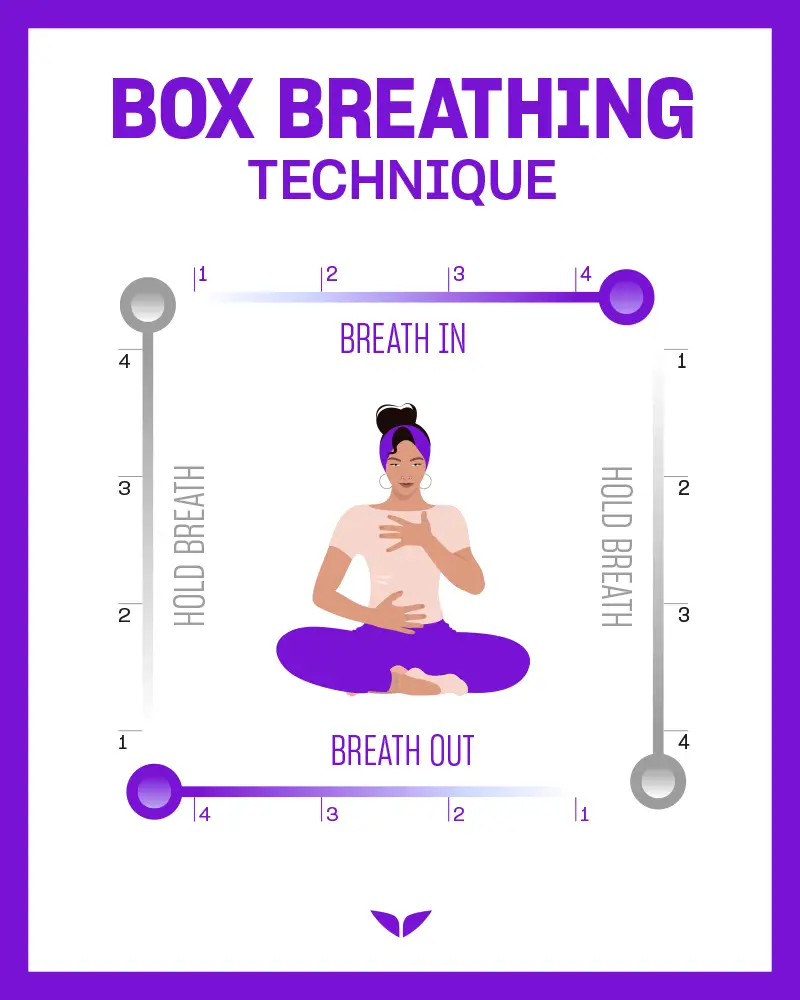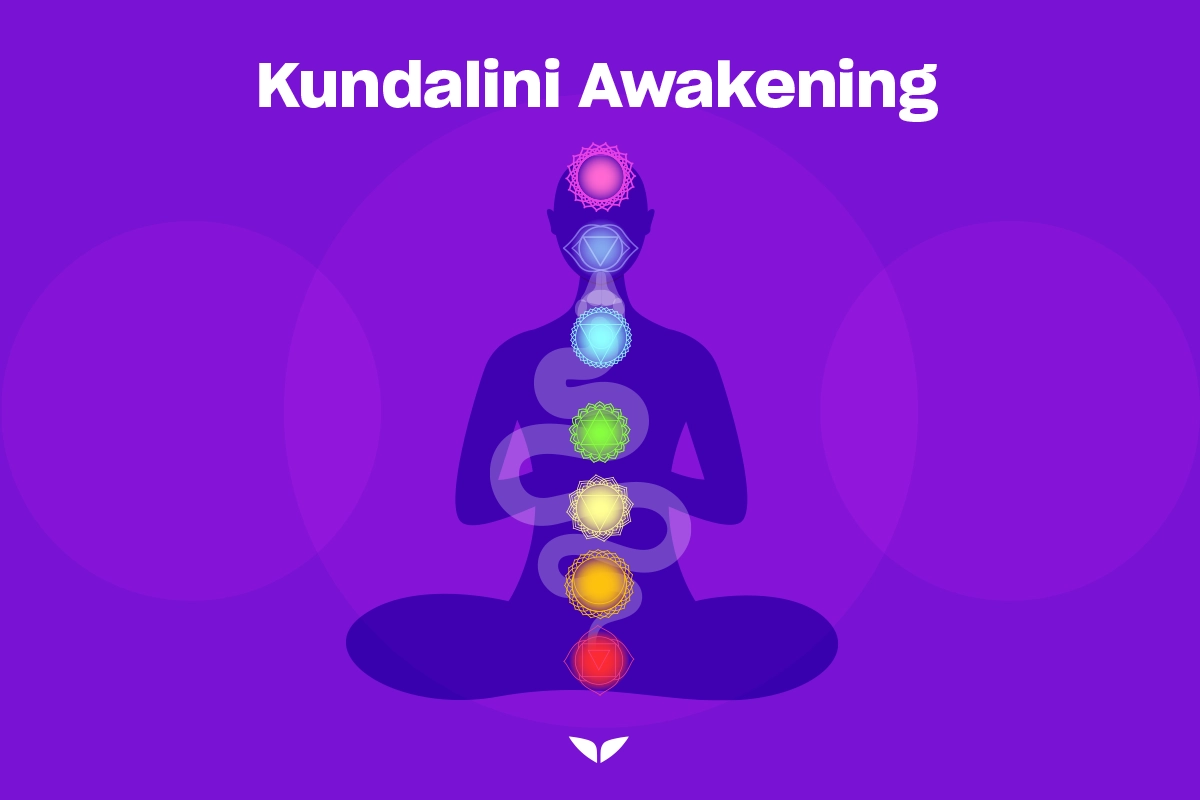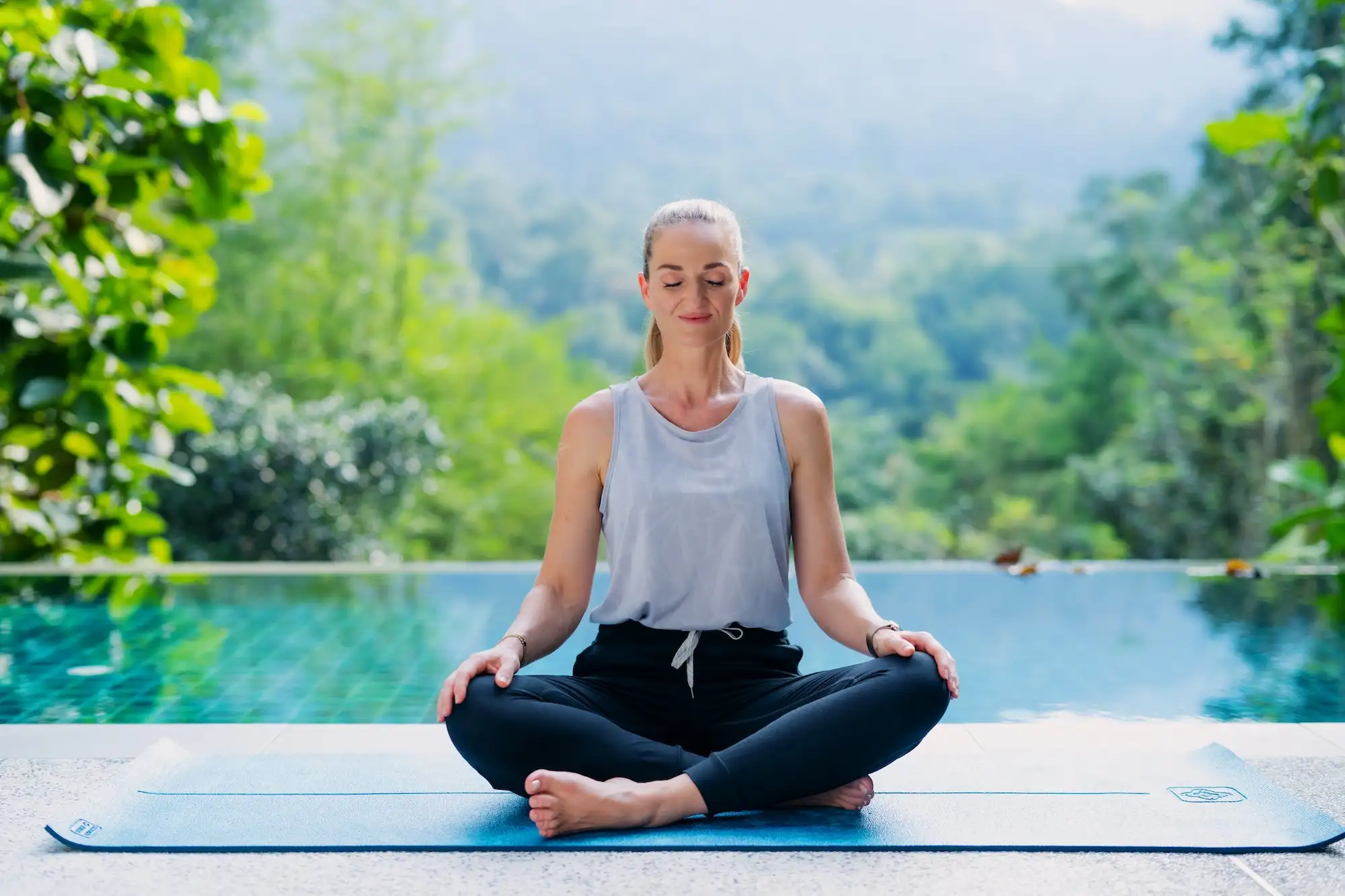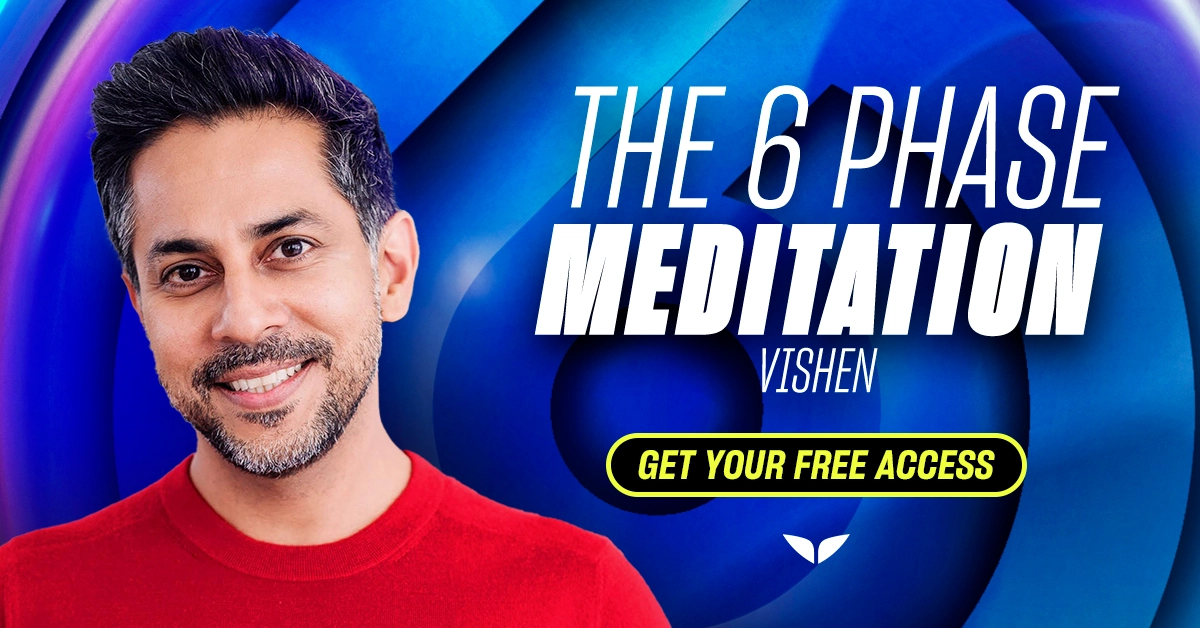Meditation. Just the word might conjure images of monks on mountaintops.
But in reality, it isn’t some exclusive ritual for a select few; it’s a practice that’s both accessible and profoundly transformative for all. For centuries, it’s been a way of calming the mind and even healing the body, with science backing up its various benefits.
What’s even more awesome? You don’t need a guru or a Himalayan retreat to tap into its power. In fact, all you really need are the right meditation techniques for you to get started.
Some are straightforward, while others might take a little more effort to master. But most are easy to learn, even if you’re new to the practice.
How many meditation techniques are there?
Believe it or not, there are thousands and thousands of meditation techniques practiced around the world. Many are rooted in the mind-body synergy traditions of Buddhism and Hinduism, while others draw from modern wellness approaches like mindfulness and breathwork.
Despite this versatility, people tend to think of meditation as just one thing: sitting cross-legged in a lotus position, spine perfectly straight, breathing on cue… and that’s it.
Obviously, that’s not all there is to meditation. And Vishen, the founder and CEO of Mindvalley, would agree.
In his 6 Phase Meditation Quest, he explains that what we often envision as the go-to meditation approach is, in fact, “hermetic meditation,” which is a style dating all the way back to ancient China and India. But it’s only one of many.
“Back then, you didn’t have WhatsApp messages to answer, a 9-to-5 job, or kids to get off to school,” he says. “People could sit under a banyan tree and meditate for hours. But in today’s world, that’s just not practical.”
The goal of meditation is to reach those powerful states of peace and positivity within the timeframe we have each day. Modern techniques can fit seamlessly into busy lives. But if you prefer a more traditional approach, that works, too.
Whichever of the meditation techniques fits your unique needs and lifestyle, what matters most is that you can still reap the scientifically-backed benefits they offer.
And there are plenty. For one, meditation has been proven to significantly aid in stress reduction by lowering cortisol levels and easing physical symptoms of tension. Meanwhile, since it’s a form of mindfulness-based intervention, it helps individuals process emotions more effectively.
So, no matter which technique you choose, the main point here remains: you get to choose how you want to meditate.
5 best meditation techniques for beginners
Starting anything new can be intimidating at first. But then again, it can be advantageous once you get the hang of it.
The key to choosing meditation techniques for beginners is to make sure that they’re 1) accessible, 2) straightforward, and 3) easy to fit into your routine.
Below are some that may just be up your alley.
1. Mindfulness meditation
Mindfulness meditation is meditation in its simplest form, and it’s the gateway for many beginners.
It’s the art of simply being present. You’re not trying to empty your mind or force calmness; you’re just observing what’s there, moment by moment.
As Tibetan Buddhist monk Pema Chödrön would say, “Meditation practice isn’t about trying to throw ourselves away and become something better. It’s about befriending who we are.”
So, by embracing mindfulness through meditation, you get to return to yourself.
Is this right for you?
If you’re someone who’s constantly juggling thoughts and trying to find a moment to breathe, mindfulness is your friend. It’s gentle, requires no unique setup, and is perfect if you’re looking to manage stress or curb overthinking.
How to do it:
- Find a quiet spot, sit comfortably, and close your eyes.
- Breathe naturally, focusing on the sensation of your breath.
- When your mind wanders (because it will), just bring it back to your breath.
- Start with five minutes, and work up from there.
Here’s a guided experience from Mindvalley to initiate you onto the mindfulness trail:
2. Loving-kindness meditation
Loving-kindness meditation, also known as Metta meditation, gets you to radiate positive vibes outwards. The idea is that you start by sending love to yourself before extending thoughts of compassion and goodwill to others to kickstart a ripple effect of kindness.
While doing this, you can picture an image or even a color that represents love to you. Vishen endorses this approach in his 6 Phase Meditation Quest, saying, “Simply doing this changes your heart resonance to a healthier, more beneficial level for your wellbeing.”
Is this right for you?
Are you dealing with negative self-talk? Perhaps you’re looking to build a more compassionate outlook on life and other people? This technique will help with that. Think of it as a gentle, heart-centered mood booster, if you will.
How to do it:
- Sit comfortably and close your eyes.
- Start actively thinking kind thoughts to yourself, such as “May I be happy,” “May I be healthy,” and “May I be at peace.”
- Then, extend these wishes to others, from loved ones to acquaintances, through statements like “May the people in my life have good health” and “I send love and peace to all of mankind.”
3. Walking meditation
Not all meditation requires you to sit still. Yep, there are options that have you move around, such as walking meditation.
This practice combines movement with mindfulness, so each step is intentional and imbued with self-awareness. At the bare minimum, it’s a great way to sneak meditation into your day without worrying about location—you can do it in a park, around your home, or at your workplace.
Is this right for you?
This is one of those meditation techniques that is ideal if you find sitting meditation difficult or prefer a more active approach. It’s also perfect for taking a mental break during a busy day, especially if you’re into daily walks.
How to do it:
- Find a quiet space to walk slowly.
- Focus on each step—the feel of your feet hitting the ground, the movement of your legs.
- If your mind drifts, gently bring it back to the rhythm of your steps.
- If you like, you can also add a positive word or phrase of your choice that you can repeat with every stride, such as “Everything is fine” and “I am empowered.”
4. Guided visualization
Guided visualization is all about using your imagination to feel calmer. Often led by a teacher or audio guide, this technique invites you to use images of peaceful scenes or positive outcomes to anchor your attention as you are in the now.
The outcome? Reduced mental clutter and increased relaxation.
You can enhance your meditation experience further by exploring guided visualization options on free meditation apps (such as Mindvalley) and finding one that hits the spot.
Is this right for you?
If you love leaning into your imagination and creativity without much technical guidance, then visualize away. It’s also a great technique for stress relief, motivation, or simply unwinding. In fact, research shows that it tends to create the “rehearsal effect,” which cultivates positive emotions and self-belief.
Professional tennis player Bianca Andreescu, for instance, used this technique to achieve her iconic 2019 U.S. Open victory against Serena Williams. At the post-match news conference, with her phone showing Vishen’s book, The Code of the Extraordinary Mind, a she explained that she leveraged Jose Silva’s ‘mental screen’ model, a concept covered in The 6 Phase Meditation Quest, to achieve her goal.
So, whether you want to calm down after a hectic day or sustain long-term discipline, this technique can be your gateway to a resilient mindset.
How to do it:
- Choose a guided meditation that resonates with you and press play.
- Sit or lie down in a comfortable position, then close your eyes and relax.
- Imagine a serene place, like a peaceful beach or a lush forest. Picture it vividly, focusing on the sounds, scents, and colors around you.
- Allow any stress to melt away as you immerse yourself in the scene.
5. Body scan meditation
This technique is all about reconnecting with your body—one part at a time. Focus on each body part, notice any tension, and then release it.
Why is meditation the bedrock of body awareness? According to Emily Fletcher, a meditation expert and the founder of Ziva Meditation, it’s because of how meditation helps to counter stress.
In her Mindvalley Quest, The M Word, she explains that our fight-or-flight response, which was once useful for survival, has now become maladaptive in today’s high-stress environments. Our “demands are in-laws, work deadlines, or red-eye flights, not saber-toothed tigers.”
Meditation, she adds, “is giving your body rest… getting rid of that adrenaline and cortisol, and flooding your brain with dopamine and serotonin.” This ultimately helps restore balance and improve body awareness.
With body scan meditation, you can directly experience this process.
Is this right for you?
If you’re finding it hard to be in your body, this technique can help. By focusing on and releasing tension in each body part, you’re actively tuning into your body’s state and promoting physical relaxation—supporting that deeper, balanced awareness Emily describes.
How to do it:
- Lie down somewhere comfortable and close your eyes.
- Start focusing on the top of your head.
- Move slowly down your body, paying attention to each area.
- Zero in and mentally release any tension you find with your breath.
Vishen’s Centering Exercise is a great way to start. As a critical component of his Silva Ultramind System Quest, the practice can help you get comfortable within your own skin again, from top to toe.
5 meditation breathing techniques to keep you grounded
Breathwork is the bedrock of many meditation techniques, acting as both an anchor and a means to achieve deeper relaxation. Different breathing styles present different benefits, from reduced anxiety to recentering of the self.
Research shows that controlled breathing can stimulate the parasympathetic nervous system, which helps reduce stress and increase overall tranquility. Then there’s the fact that when done slowly, it can also improve heart rate variability (HRV), which promotes relaxation while keeping stress at bay.
What’s even more amazing? Breathing techniques during meditation can also create an internal balance by engaging both hemispheres of the brain—a fact that Emily herself always celebrates.
“I don’t think that nature makes mistakes. I don’t think that nature would have given us 50/50 if it wanted us to use 90/10,” she says. “And so that’s what we’re going to be doing in balancing breath: we’re going to be taking our right brain to the gym so that our right and left hemispheres of the brain can start to talk to each other.”
With that in mind, below are some foundational meditation breathing techniques that keep you centered while taking your practice from “newbie” to “seasoned” over time.
6. 4-7-8 breathing
Developed by celebrity doctor Dr. Andrew Weil, the 4-7-8 breathing helps reset your nervous system and bring your body into a relaxed state.
Is this right for you?
This method can work wonders whenever you’re in need of a quick, calming reset during the day. It’s also a beneficial bedtime hack, as it helps ease the body into relaxation.
How to do it:
- Begin by sitting comfortably and closing your eyes.
- Inhale quietly through your nose for a count of four.
- Hold your breath for a count of seven.
- Exhale through your mouth for a count of eight, making a soft “whoosh” sound.
- Repeat the cycle four times for an optimal relaxed effect.
7. Box breathing
Box breathing, also called square breathing, is frequently used by athletes, first responders, and people in high-stress careers. It’s a rhythmic breathing technique often used to reduce stress and enhance concentration.
Is this right for you?
As a versatile technique, it can be done anywhere. But it’s especially great for improving your focus before a high-pressure situation.
How to do it:
- Start by inhaling slowly through your nose for a count of four.
- Hold your breath for another count of four, then exhale through your nose for four counts.
- Finally, hold your breath out for four counts before starting the cycle again.
- Repeat as many times as needed until you’re fully centered inside.

8. Belly breathing
Belly breathing, or diaphragmatic breathing, encourages deeper breaths by engaging the diaphragm rather than shallow chest breathing. This technique can help improve oxygen flow and reduce tension.
Is this right for you?
If you find yourself with anxiety attacks, muscle tension, and general stress, this practice is a great one to try. Those new to meditation tend to love it since it requires minimal guidance. What’s more, it can be integrated into other meditation styles, making it a versatile option.
How to do it:
- Place one hand on your chest and the other on your belly.
- Inhale deeply through your nose, allowing your diaphragm to expand so your belly rises while your chest remains still.
- Exhale slowly through your mouth, feeling your belly fall.
- Repeat for several minutes, focusing on the rise and fall of your belly.
9. Coherent breathing
A popular breathing exercise in the West, coherent breathing is said to originate from Pranayama, the ancient Vedic practice of breath control. It closely resembles a variation of sama vritti pranayama (or “even breath” in Sanskrit), which also follows an even breath ratio to calm your nervous system.
Is this right for you?
Whenever you’re experiencing high stress, this technique can quickly bring your heart rate into a balanced rhythm and is effective for daily relaxation. It’s also an evergreen tool to turn to when transitioning from work to personal time or winding down at the end of the day.
How to do it:
- Inhale for a count of five, then exhale for a count of five.
- Maintain a steady pace, keeping your breaths smooth and unforced.
- Repeat this cycle for a few minutes, aiming for six breaths per minute.
10. SOMA breathwork
Created by pharmacist-turned-breathwork expert and Mindvalley trainer Niraj Naik, SOMA Breath® combines rhythmic breathing patterns with music and visualization to activate a deep state of relaxation.
This technique is inspired by ancient pranayama practices but adapted for modern life. It blends rhythmic breathing with breath retention to boost mental clarity, energy, and inner peace.
Is this right for you?
SOMA Breath®’s rhythmic, dynamic nature is ideal if you’re drawn to an active form of meditation.
It’s also an excellent choice if improving your sleep hygiene is a priority—this breathwork technique is known to help ease the body into relaxation. You can see how it’s especially useful when you’re learning how to meditate in bed.
How to do it:
- Sit or lie down comfortably in a quiet space.
- Begin with a rhythmic breathing pattern: inhale through your nose for a count of two, then exhale through your mouth for a count of four.
- Keep this rhythm going for a few minutes. After a few rounds, hold your breath for a comfortable length of time before resuming rhythmic breathing.
To get a glimpse of how good this meditation technique can be, check out this guided SOMA breathwork meditation led by Niraj himself:
5 meditation techniques for anxiety
While meditation isn’t a magic wand to make anxiety disappear, it can be a powerful tool for managing those overwhelming moments effectively.
Here are a few meditation styles explicitly designed to help calm anxious thoughts:
11. The 333 technique
The 333 technique is a simple, effective method for bringing yourself back to the present when anxiety strikes. It involves engaging your senses and directing your attention to your surroundings, helping you regain control and ground yourself in the moment.
This technique encourages a quick mental shift, easing anxious thoughts and providing a sense of calm through mindful awareness.
Is this right for you?
If you struggle with sudden bouts of anxiety or find it hard to stay focused during stressful situations, the 333 technique can be a lifesaver. It’s quick, discreet, and can be done anywhere, making it ideal for managing anxiety on the go.
How to do it:
- Identify three things you see. Look around you and notice three distinct objects in your environment. Say each one out loud or in your mind.
- Listen for three sounds. Pause and tune into your surroundings. Identify three sounds you can hear, whether they’re close or distant.
- Move three body parts. Shift your focus to your body. Move three parts, such as wiggling your fingers, rolling your shoulders, or stretching your legs.
12. Zazen meditation
Zazen—which is another name for Zen meditation—is as straightforward of a meditation as it gets. Rooted in simplicity, it’s a seated meditation that focuses on posture and breath awareness. There’s no mantra, no guided visualization—just you, your breath, and a lot of stillness.
Is this right for you?
Definitely, if you’re a minimalistic meditator. This no-nonsense approach is the one if you find clarity through simplicity and your end goal is increased spirituality through patience.
How to do it:
- Sit cross-legged or on a cushion, keeping your spine straight.
- Focus on your breath, letting each inhale and exhale be the anchor. Keep your eyes slightly open, looking downwards to maintain awareness.
- When thoughts arise, acknowledge them, then gently bring your focus back to your breath. Remember: the goal is to let them go.
13. The butterfly hug technique
The butterfly hug is a gentle self-soothing technique often used in trauma and anxiety therapy, particularly in eye movement desensitization and reprocessing (EMDR) therapy. It involves crossing your arms over your chest and lightly tapping your shoulders to recenter yourself.
Research has shown that bilateral stimulation, like the tapping used in the butterfly hug technique, can help reduce the intensity of traumatic memories and alleviate anxiety by promoting emotional regulation and grounding.
Is this right for you?
If you tend to experience physical restlessness during anxious moments or are deep in trauma-processing work, then this one’s for you. The comforting physical action can calm both the body and the mind, making it easier to ground yourself as quickly as possible.
How to do it:
- Cross your arms over your chest, placing your hands on opposite shoulders.
- Begin tapping your shoulders alternately with each hand, left and then right, creating a steady rhythm.
- Focus on the rhythm and the calming sensation, allowing any anxious thoughts to fade as you reconnect with your body.
14. Mantra meditation
Mantra meditation involves silently repeating a calming word or phrase—a “mantra”—to anchor your mind. This technique helps redirect anxious thoughts by giving you a focal point that helps you stabilize your mind.
Is this right for you?
This method is suitable for you if you struggle with spiraling thoughts and need something steady to focus on. It is also helpful if you’re sensitive to noise or distractions, as the mantra naturally draws your attention inward.
How to do it:
- Sit comfortably, close your eyes, and take a few deep breaths.
- Repeat a phrase that brings you comfort, like “Everything’s peaceful” or “I am calm and centered.”
- Silently repeat this mantra with each breath, allowing it to fill your mind. If your thoughts wander, gently bring them back to the mantra.
- Repeat for a few minutes until you feel grounded again.
15. Backward counts
Counting backward is a straightforward mental exercise that helps divert your mind from anxious thoughts. By focusing on counting, you create a mental distraction that allows the anxious energy to dissipate gradually.
Is this right for you?
Whenever you are plagued by racing thoughts or spiraling “what if” scenarios, this approach can bring in the calm. It’s quick, easy, and can be practiced anywhere without drawing attention to yourself, making it effective for dealing with anxious moments on the go.
How to do it:
- Find a comfortable position or stay seated wherever you are.
- Begin counting backward from 100, focusing solely on the numbers.
- If you lose track, simply start again from 100, keeping your mind anchored on the task.
- Repeat until you feel your mind gradually calming down.
5 deep meditation techniques to boost your self-awareness
When you’re ready to go beyond the basics, deep meditation techniques can help you step into another layer of yourself—one where calmness is an ever-present state you can always go back to.
These techniques give you a pathway to a quiet, spacious awareness that you can carry with you. If that sounds like what you’re looking for, here are some transformative practices to try:
16. Transcendental meditation
Developed by Maharishi Mahesh Yogi, transcendental meditation (TM) is a structured, silent mantra-based technique. It’s specifically designed to bring the mind into a state of restful awareness.
But there’s more to it. Turns out, TM can also significantly reduce stress and alleviate stress-related symptoms, thus supporting cardiovascular health, slowing aging effects, and boosting overall well-being.
Unlike the more general mantra meditation, which may vary in practice and frequency, TM is practiced for 20 minutes, twice daily, with a unique, personalized mantra assigned by a certified TM teacher to fit your needs.
Is this right for you?
This one’s for you if you’re looking for a consistent, evidence-backed approach to meditation that goes beyond simple relaxation. It’s especially suited for people who appreciate a regular, structured routine and clear guidance on how to practice effectively.
How to do it:
- Find a TM instructor. TM requires a personalized mantra—typically provided by a certified instructor.
- Practice in a quiet setting. Sit comfortably with your eyes closed and take a few deep breaths to relax.
- Silently repeat your mantra. Focus on your specific TM mantra, allowing it to effortlessly guide you into a quiet, transcendent state. Avoid active concentration; instead, let the mantra bring your mind to a place of natural stillness.
- Allow thoughts to come and go. Instead of forcing thoughts away, let them drift naturally, knowing they’ll settle as you return your focus to the mantra.
- Practice twice daily for 20 minutes. TM’s structure is part of its power—try to make time for it in the morning and evening, ideally before meals.
17. Yoga nidra meditation
Yoga nidra, often referred to as “yogic sleep,” is a state of conscious relaxation that bridges wakefulness and deep slumber. The practice guides you into a profound level of rest where your body remains fully relaxed, yet your mind stays alert—without dozing off.
Unlike meditation, which relaxes you, sleep actually prepares the “fight or flight” response for wakefulness. So, when we meditate, Emily says, “our body is getting rest that’s even deeper than sleep. Now, how do we know that? Our metabolic rate drops, our heart rate slows, and our body temperature cools, all of which is giving us this deep body rest.”
This deep level of relaxation is ultimately why yoga nidra is so effective for easing anxiety and restoring the mind-body balance.
Is this right for you?
If you struggle with insomnia or anxiety or find it hard to unwind fully, yoga nidra can be your new go-to hack. It’s done lying down, so it’s excellent for when you want to go deep into the non-sleep deep rest mode without sitting up.
How to do it:
- Lie down somewhere comfy and close your eyes.
- If possible, follow a guided session that takes you through each part of your body, helping you release tension.
- As you go deeper, allow yourself to drift between wakefulness and rest.
- Practice for 20–40 minutes, and let this time be yours.
18. Kundalini meditation
With an origin in ancient yogic traditions, kundalini meditation focuses on awakening energy that lies dormant at the base of your spine, allowing it to rise through your chakras (or energy centers). This approach often incorporates techniques like breathwork, mantras, and specific body movements that set it apart from other meditation styles.
Kundalini meditation is best practiced with proper guidance. So, make sure that the meditation classes you attend for this approach are led by a trustworthy, certified teacher.
Is this right for you?
If you’re craving a spiritual experience or feel drawn to explore energy work, kundalini meditation may be the transformative practice you’re looking for. It’s a bit of a lengthy journey that requires your commitment, but once you’re in, you’ll see its rewards.
How to do it:
- Start seated with a straight spine, taking deep, slow breaths.
- You can incorporate mantras, breathing patterns, or even certain hand gestures (mudras) to guide your energy flow.
- As you settle into the practice, focus on visualizing the energy at the base of your spine.
- With each breath, imagine it rising gently upward through each chakra point to the top of your head (the crown chakra).

19. Vipassana meditation
Vipassana—which means “insight” in the ancient Pali language—is the oldest form of Buddhist meditation. It requires you to scan your body for sensations and observe your thoughts without judgment along the way.
When immersed in this practice, do expect to face every facet of yourself. It helps bring unresolved issues into your awareness so you can accept them before letting go.
Is this right for you?
If you’re on a journey of self-discovery or crave a deeper understanding of your mind, then definitely give this a try. It’s often practiced on retreats over extended periods, so it’s best for those ready for a deep dive.
How to do it:
- Sit comfortably and close your eyes, focusing on your breath to start.
- Begin scanning your body, noticing each sensation as you go. Avoid judgment—just observe.
- Allow yourself time to sit with each sensation and thought so you can learn to accept they exist without any attachment.
20. The 6 Phase Meditation
In the 6 Phase Meditation, we don’t ignore our thoughts… We transform them.
— Vishen, founder of Mindvalley and trainer of the 6 Phase Meditation Quest
Created by Vishen, this modern approach to mindfulness combines six incredibly powerful meditation phases into one. Each phase addresses different aspects of personal growth and well-being, from gratitude and forgiveness to setting intentions and visualizing future goals.
This structured practice is designed to give you a holistic mental reset, allowing you to face your day with clarity and purpose. Instead of pushing away your thoughts, this practice encourages you to engage with them in a constructive way.
“In the 6 Phase Meditation, we don’t ignore our thoughts,” Vishen explains. “We bring them into our being and we transform them. We turn problems into projects.”
Is this for you?
This meditation fits you if you’re looking to go beyond relaxation and want to actively shape your mindset and life. And it’s especially beneficial if your schedule is busy, as it covers a range of transformative practices in one guided session.
Even high-level performers with demanding routines have turned to this structured meditation for its efficiency and impact. Take former NFL star Tony Gonzalez, for instance. In an interview with The New York Times, he once credited Vishen’s guided meditations as the fuel for his emotional resilience during his active years.
How to do it:
The unique meditation approach is broken into six parts, each designed to focus your mind and shift your state:
- Connection. Begin by connecting with a feeling of unity and oneness, grounding yourself in a sense of belonging.
- Gratitude. Reflect on things you’re grateful for in your personal life, work, and self, cultivating a positive mindset.
- Forgiveness. Let go of any negative feelings by practicing forgiveness, releasing emotional burdens, and creating inner peace.
- Visualization. Picture your ideal future—what you want to manifest in your life—as vividly as you can. Zero in on the details, from where you want to be to who you want to surround yourself with.
- Daily intention. Set an intention for your day, focusing on what you want to feel, do, and accomplish.
- Blessings. Close by imagining yourself surrounded by positive energy, feeling supported and protected.
Follow a guided session led by Vishen himself, who’ll walk you through each phase with precision and intention:
5 simple meditation techniques to help you stay centered
Sometimes, all you need is a quick, easy way to clear your mind and inject some effortless “zen” into your day. Cue simple meditation techniques, which are perfect for when you’re pressed for time, new to meditation, or just want something low-maintenance.
The following techniques require minimal effort yet offer maximum relaxation benefits—no complicated steps or intense focus required.
21. The one-minute reset
This quick hack is what it sounds like—a one-minute pause to focus on your breath. It’s designed to help you reset quickly and is perfect for those hectic days when you barely have a moment to yourself.
Is this for you?
It’s simple, adaptable, and doable anywhere, whether you’re sitting at your desk or waiting in line. So, evidently, it’s ideal for anyone and everyone looking for a quick mental break.
How to do it:
- Close your eyes (or keep them open if you’re in a public space) and take a slow, deep breath through your nose.
- Hold your breath for a couple of seconds, then exhale slowly through your mouth.
- Repeat this pattern for one minute, focusing only on the sensation of your breath. Let any stress or tension melt away as you breathe.
22. Easy breath counts
This technique is all about simplicity and is foundational to any meditation style that ever exists. By counting each breath, you give your mind something gentle to focus on, letting you unwind without overthinking it.
Unlike backward counting, which can sometimes feel like a countdown to a specific point, easy breath counts are sequential and open-ended. This keeps your focus gently tethered to the present, free from any sense of urgency to complete something.
Is this for you?
It’s a great choice if you’re easily distracted and struggle to focus. For instance, if you’re waiting for a meeting to start or feeling overwhelmed by your to-do list, counting your breaths can gently reel you back into the present moment.
How to do it:
- Sit comfortably and start to breathe naturally.
- On your inhale, count “one” in your mind; on your exhale, count “two.”
- Keep going up to ten, then start over.
- If your mind wanders, just bring it back to the count.
23. The “anchor word” method
An anchor word is a single word or phrase that you repeat to bring yourself back to your center. It’s a mental “reset button” you can press anytime to pull yourself out of stress.
Unlike techniques that require longer focus or rhythm—such as mantra meditation or breath counts—an anchor word acts as an instant mental reset tool, bringing you back to a baseline state of neutrality within seconds.
Is this right for you?
This technique is fantastic for those moments when you’re feeling scattered or need grounding— fast. Imagine you’re about to go into an important conversation, and your nerves are firing up. Using an anchor word like “calm” or “steady” can help you center yourself in seconds, without anyone noticing.
How to do it:
- Pick a word or phrase that feels comforting, like “peace,” “flow,” or “I am here.”
- Close your eyes and repeat the word in sync with your breath.
- Let this anchor word draw you into a calm space.
- Let go of any physical or mental tension you sense with each repetition.
24. Focus on your hands
Sometimes, the simplest things are the most powerful…and directing your attention to the sensation in your hands in any stressful moment is one of them.
Is this for you?
Yes, this technique is ideal if you need a subtle way to ground yourself in stressful situations. It’s especially helpful for quieting panic in public spaces or meetings.
For instance, you can turn to an anchor word when you’re feeling overwhelmed in a crowd or facing anxious thoughts on a busy day.
How to do it:
- Sit comfortably and place your hands in your lap, palms up.
- Close your eyes and focus on your hands.
- Notice any warmth, tingling, or heaviness that arises.
- Keep breathing naturally as you continuously make these sensations your focal point.
- Feel the stress or tension in your mind and body ease up.
25. Barefoot walking
This straightforward technique, also known as earthing, is as versatile a meditation hack as it can get.
You see, walking barefoot helps you connect with natural textures and temperatures, which, according to the book Biophysics of Earthing The Human Body by James L.Oschman, Gaétan Chevalier, and Clinton Ober, can reduce inflammation. This is a real solid health benefit, as inflammation is the root cause of many diseases.
What’s more, this unassuming technique can also lift your mood and boost your energy by releasing any harmful electrical charges in your body into the earth.
Is this for you?
Yes, if you love nature and enjoy quiet walks. Try this when you’re feeling disconnected or simply craving a fresh dose of natural calmness—you’ll likely feel rejuvenated in a matter of minutes.
How to do it:
- Find a safe, natural surface like grass, sand, or soil, and remove your shoes.
- Start walking slowly, focusing on the sensations beneath your feet—the texture, temperature, and pressure of the ground beneath you.
- Breathe deeply and stay aware of each step, letting the experience ground you in the present moment.
- Allow any thoughts to pass without attachment with every stride, using your momentum as your anchor.
Bonus: How to choose the right meditation technique for you
With so many meditation techniques available, finding the one that fits your needs might feel overwhelming. But choosing doesn’t have to be guesswork.
Here’s a simple guide, along with a few reflective questions, to help you find a practice that resonates:
1. Identify your goals
Consider why you want to meditate. Are you looking for stress relief, self-discovery, or a way to boost mental clarity? Knowing your primary reason can help you zero in on the right approach.
So why is having goals pre-meditation important? Beyond just getting you to meditate in a way that suits you, it also helps you achieve the outcome you want with the practice.
Let’s say you typically get nervous when you have to give a big presentation at work (and with your job scope, you have to do it a lot). Using structured techniques, such as visualization meditation or the 6 Phase Meditation, can help you effectively manage pre-presentation jitters and cultivate confidence.
See how intended growth starts by pinpointing your meditation growth? So, get comfortable with your “why.”
Questions to ask yourself:
- “What is my primary reason for meditating?”
- “Do I want something calming or energizing?”
- “Am I seeking mental clarity, emotional balance, or spiritual growth?”
2. Consider your lifestyle
Your daily routine and time availability play a big role in choosing the right meditation practice.
If you’re often short on time, quick techniques like breath counts or one-minute resets can be effective for fitting your practice into a busy schedule.
But if you prefer a more comprehensive approach? Well, the more in-depth meditation techniques, like the 6 Phase Meditation, can provide a structured, guided experience that covers multiple aspects in a single session.
Questions to ask yourself:
- “How much time can I realistically commit each day?”
- “Do I prefer shorter, flexible practices or longer, guided sessions?”
- “Would a silent or guided approach suit my lifestyle best?”
3. Experiment with a few methods
Meditation is a personal journey, and what resonates for one person may not work as well for another. Try out different techniques for a few days each and observe how they make you feel, both during the practice and afterward.
Are certain practices helping you feel more grounded, balanced, or clear-headed? A good way to find out is through alternating between techniques.
For example, you can spend a day or a week (depending on how much time you need) to focus on breathwork meditation. Then, switch it up with any other approach you like for contrast. From here, it’s eventually easier to take stock of which approach is best for you.
Questions to ask yourself:
- “How does this technique make me feel afterward?”
- “Does it leave me relaxed, focused, or energized?”
- “Which techniques feel most aligned with my goals?”
4. Listen to your body and intuition
Ultimately, meditation is about tuning into your own needs. Pay attention to how each practice affects your body and mind.
If a particular technique leaves you feeling refreshed or centered, keep it in your rotation. At the same time, don’t hesitate to skip over the ones that feel forced or draining.
No matter which you choose, one thing’s for certain: your intuition will be your best guide as you navigate the experience.
At the end of the day, the only golden rule to remember is that meditation is a journey, not a destination. And above all, don’t forget to embrace the freedom to explore, adapt, and change your techniques as your needs evolve.
Questions to ask yourself:
- “Did this technique resonate with me on a deeper level?”
- “Do I feel drawn to practice it again?”
- “Is this technique helping me meet my goals?”
Future-proof your wellbeing
Wouldn’t it be great if, each morning, you woke up feeling more calm, with laser-sharp clarity guiding your every step? Where you feel a strength within and your mind feels light, focused, and centered, and you carry an unshakable sense of purpose.
That’s what meditation does for you. And if you’re looking for a place to start, Vishen’s 6 Phase Meditation Quest on Mindvalley comes highly recommended by those who’ve experienced its impact firsthand…
…Like Samir Shah, a musician from Upper Marlboro, U.S., who used to “worry about small things and minor health issues. Now? He’s got a clear vision of the future, thanks to the 6 Phase Meditation.
He’s not the only one. Victoria Olivadoti, an educational consultant from Fountain Valley, U.S., had never been able to meditate, but Vishen’s meditation technique opened a gateway to profound joy and clarity. “It’s been transformative,” she says. “The speed at which answers to visions of the future have materialized is mind-blowing.”
Like Samir and Victoria, you too can bring more clarity, resilience, and purpose into your life. The free program prepares you to:
- Building a transformative daily meditation practice,
- Fostering positivity and deeper connections,
- Releasing negativity and embracing forgiveness,
- Accessing inner wisdom for inspired goals, and
- So much more.
All you need to do is take that first step. As Vishen says, “Baby steps are more powerful than you think.”
Welcome in.








